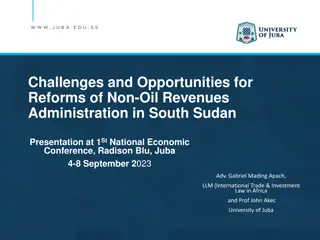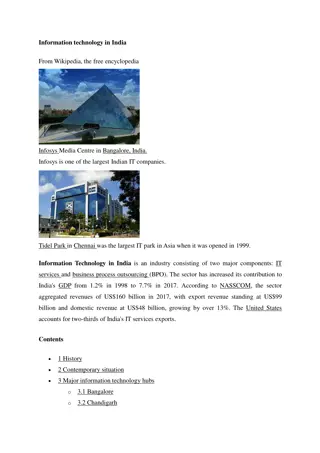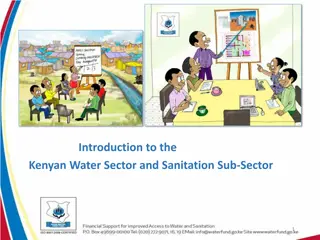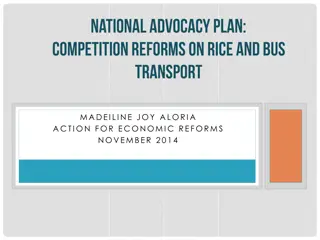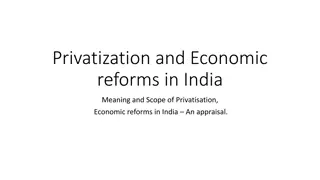Financial Sector Reforms in India: An Overview
In the early 1990s, India witnessed significant reforms in its financial sector, addressing issues like lack of transparency, extensive regulation, and financial repression. Key reforms included setting up expert committees, reducing SLR and CRR, implementing prudential norms, and deregulating interest rates. The introduction of Capital Adequacy Norms and the Recovery of Debts Act further bolstered the sector, leading to the emergence of new private banks and increased competition.
Download Presentation

Please find below an Image/Link to download the presentation.
The content on the website is provided AS IS for your information and personal use only. It may not be sold, licensed, or shared on other websites without obtaining consent from the author.If you encounter any issues during the download, it is possible that the publisher has removed the file from their server.
You are allowed to download the files provided on this website for personal or commercial use, subject to the condition that they are used lawfully. All files are the property of their respective owners.
The content on the website is provided AS IS for your information and personal use only. It may not be sold, licensed, or shared on other websites without obtaining consent from the author.
E N D
Presentation Transcript
FINANCIALSECTOR REFORMS IN INDIA RADHIKAKRISHNAN ASSISSTANT PROFESSOR DEPARTMENT OF ECONOMICS NSS COLLEGE PANDALAM
Early 1990s were Lack of proper banking system Administered interest rates Lack of proper accounting and transparency Extensive regulation Financial repression
Major sectors Banking sector Monetary policy Financial market Forex market
Banking sector reforms Two such expert Committees were set up under the chairmanship of M. Narasimham. They submitted their recommendations in the 1990s in reports widely known as the Narasimham Committee-I (1991) report and the Narasimham Committee-II (1998) Report.
Lowering SLR and CRR-The high SLR and CRR reduced the profits of the banks. The SLR had been reduced from 38.5% in 1991 to 25% in 1997. This has left more funds with banks for allocation to agriculture, industry, trade etc Prudential norms have been started by RBI in order to impart professionalism in commercial banks. The purpose of prudential norms includes proper disclosure of income, classification of assets and provision for Bad debts so as to ensure that the books of commercial banks reflect the accurate and correct picture of financial position
Capital Adequacy Norms (CAN): Capital Adequacy ratio is the ratio of minimum capital to risk asset ratio. In April 1992 RBI fixed CAN at 8%. By March 1996, all public sector banks had attained the ratio of 8%. It was also attained by foreign banks. Deregulation of Interest Rates-The Narasimhan Committee advocated that interest rates should be allowed to be determined by market forces. Since 1992, interest rates have become much simpler and freer.
The Government of India passed the Recovery of debts due to Banks and Financial Institutions Act 1993 in order to facilitate and speed up the recovery of debts due to banks and financial institutions. Six Special Recovery Tribunals have been set up. An Appellate Tribunal has also been set up in Mumbai. New private sector banks have already started functioning. These new private sector banks are allowed to raise capital contribution from foreign institutional investors up to 20% and from NRIs up to 40%. This has led to increased competition.
Scheduled Commercial Banks are given freedom to open new branches and upgrade extension counters, after attaining capital adequacy ratio and prudential accounting norms. The banks are also permitted to close non-viable branches other than in rural areas. The RBI has set up a Board of financial Supervision with an advisory Council to strengthen the supervision of banks and financial institutions. In 1993, RBI established a new department known as Department of Supervision as an independent unit for supervision of commercial banks.
Permission to banks to diversify business activities like merchant banking, underwriting, mutual funds, insurance to increase productivity ,competency and profitability Phasing out of directed credit programmes and redefinition of priority sector Asset classification into4-Standard or performing assets,sub-std assets(remains NPA forless than 18 months)doubtful assets(excd 18 months) and loss assets (cannot be recovered)
Banking ombudsman scheme 1995 was started for redressing grievances of public against banks Banks were asked to disclose and share any information regarding defaulting borrowers to improve the recovery and discipline among borrowers. Banks were required to categorize their assets into performing and non performing.an asset became an NPA if the borrower does not pay dues for a period of 90 days.
CAPITAL MARKET REFORMS An important measure regarding capital market reforms is the setting up of Securities and Exchange Board of India (SEBI) as the regulator of equity market in India. Another important reform is the permission granted to the private sector firms to start Mutual Funds. Many private sector companies such as Tata, Reliance, Birla have set up their mutual funds through which they raise money from the public.
Indian capital market has been opened up for foreign institutional institutions (FII). That is, FII can now buy shares and debentures of private Indian companies . The Indian corporate sector has been allowed to raise funds in the international capital markets through American Depository Receipts (ADRs), Global Depository Receipts (GDR), Foreign Currency Convertible Bonds (FCCBs) and External Commercial Borrowings (ECBs). Similarly, Overseas Corporate Bodies (OCBs) and Non-resident Indians have been allowed to invest in the equity capital of the Indian companies,stock market and can also invest in government securities
banks have been allowed to lend against various capital market instruments such as corporate shares and debentures to individuals, investment companies, trusts and endowment share and stock brokers, industrial and corporate buyers and SEBI-approved market makers. Establishment of Creditors Rating Agencies : The Investment Information & Credit Rating Agency of India Limited (ICRA - 1991) The Credit Rating Information Services of India Limited (CRISIL - 1988) & CreditAnalysis and Research Limited (CARE) were set up in order to assess the financial health of different financialinstitutions & agencies related to the stock market activities.
Depositories Act was passed in 1996 and NSDLand CDSL estd Stock exchanges were demutualised.(owned and operated by shareholders and not by traders) Many Indian & foreign commercial banks have set up their MBD (Merchant Banking Divisions) in the last few years. MBD provide financial services such as consultancy services, underwriting facilities, issue organizing,etc. The Insurance Regulatory & Development Authority (IRDA) was set up in 2000. The main purpose of IRDA is regulating the Insurance companies in India(i.e Public & Private Sectors)
IMPACT OF CAPITAL MARKET REFORMS New and innovative Fin.instruments Active participation of FII s Shorter trade cycles Growth of stock exchanges and derivative mkt More technology application Establishment of NSE Measures to protect investors and setting up of IEPF Trades in DEMAT form,newinstruments Demutualization of SE
EXTERNAL SECTOR REFORMS IN INDIA Flexible exchange rate system was introduced An important policy in external sector has been to open up the Indian economy to foreign trade. In place of import-substitution, export-led growth strategy has been adopted. The Indian rupee was made convertible on current account transactions. This facilitated the foreign exchange transactions at the exchange rate determined by market forces. Foreign Investment Promotion Council Board was estd to promote foreign investments in India. Automatic approval scheme for FDI was introduced in many industrial sectors
Another important reform in the external sector was Foreign Exchange Regulation Act (FERA) was replaced by Foreign Exchange Management Act (FEMA). The stringent provisions of FERA had become obsolete in the context of liberalisation of foreign trade, foreign investment and foreign ex- change market in the early nineties. Encouraging FDI by increasing maximum limit on share of foreign capital in joint ventures from 40to51%
IMPACTOF EXTERNAL SECTOR REFORMS SustainableBoP Volatality of exchange rate reduced Foreign Investment,portfolio investment etc increased Exports increased


